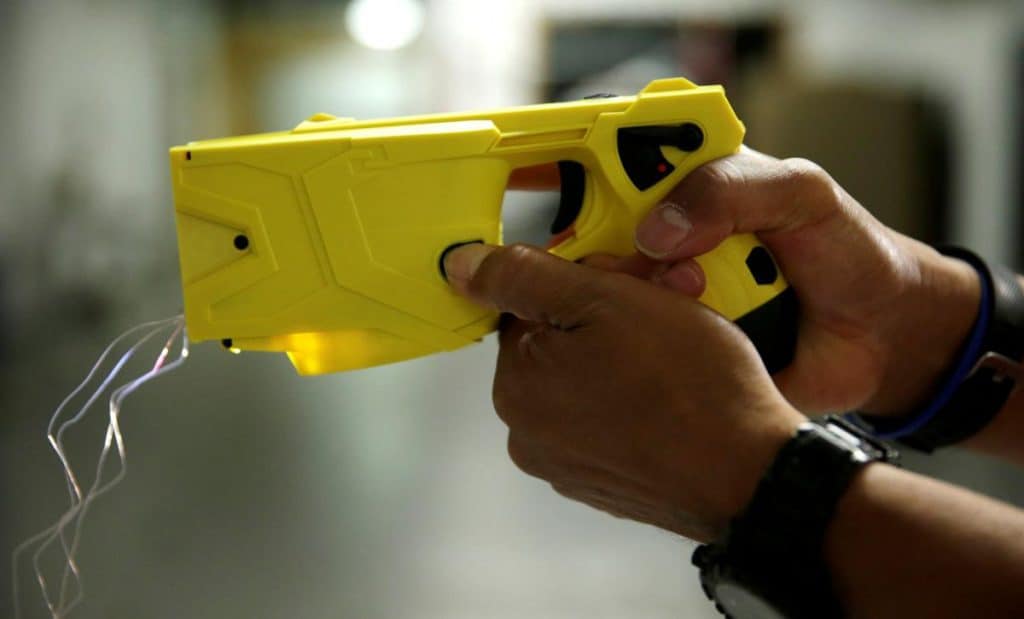If you’ve been considering purchasing a taser for yourself for self-protection, you may be wondering — how many volts are in a taser? Exactly how strong is the weapon you’re considering purchasing for yourself? Does the voltage of such a weapon actually matter, or will any taser work just fine?
So, how many volts in a taser? Most of your average tasers transfer up to 50,000 volts to the person being tased.
However, there are many varieties of tasers, so you can purchase tasers that are both much weaker and much stronger than 50,000 volts. If you are interested in purchasing a taser for yourself for self-defense (or if you’re a law enforcement officer looking for a new weapon), then take a look at some of our favorite models.
- Optimized self-defense range: 15-foot Shooting distance, ideal for most defensive situations
- Powerful protection ensures a safe escape: 30-second muscular override gives you time to get away, and we'll replace your TASER device free of charge
- Effective up close: contact stun capabilities help at close range or in the event of a missed shot

What Is A Taser, And What Are They Used For?
A taser is a small, handheld weapon used by both law enforcement officers and average citizens as a form of self-defense. Often, law enforcement officers use tasers as a way to stop and arrest criminals attempting to escape capture, or to prevent bodily harm to themselves in an attack (before using a real gun). They can also be used on both humans and small-to-medium sized animals, such as rabid and uncontrolled dogs or wolves.
Tasers look like small guns, and they use pressurized nitrogen to shoot two barbs into the victim, supplying the victim’s muscles with 50,000+ volts of electricity. This causes the victim’s muscles to seize up, temporarily paralyzing them. This allows the person administering the taser a chance to escape attack.
Because a taser uses electricity and nitrogen, rather than bullets and gunpowder, they are not considered firearms and are not as heavily regulated
What’s The Difference Between A Taser And A Stun Gun?
Although these terms are often used interchangeably, tasers and stun guns are actually different types of weapons. A taser looks like a gun, and shoots barbs into the victim from up to 35 feet away to deliver a series of electric shocks.
A stun gun, although it also delivers a series of electric shocks to the victim, cannot be shot from a distance towards the victim. Instead, the administrator of a stun gun must press the stun gun directly into the victim to give them a series of shocks. They also tend to be much smaller and better hidden than tasers, making them more favorable amongst average citizens.
Tasers are also much more expensive than stun guns, so if your wallet isn’t quite ready to handle a taser yet, you can definitely get a stun gun on the cheaper side in the meantime. You can find more information about the difference between tasers and stun guns online, and can also see how stun guns are used on YouTube.
Why Does Voltage Matter?
The amount of voltage produced by a taser often indicates the strength of the electrical shocks that will be administered to the victim. However, the amount of volts are different from the amount of amps, which also contributes to the strength of the shocks given by the weapon.
The higher the voltage or amperage on a taser, the stronger the shocks administered will be (and thus the stronger an effect the taser will have on the victim).
The smaller the number, the less strong the weapon is. Although some people (such as gun enthusiasts, weapon enthusiasts, and law enforcement officers) may be interested in the strongest tasers on the market (which can be upwards of 600,000 volts), average citizens such as you and I might not be comfortable carrying a weapon with that much strength. For us, weapons with less voltage or amperage might be less anxiety-inducing to carry around for self-defense and protection, and are good for beginners (especially if you’ve never used a taser or stun gun before).
According to my research, the smallest voltage possible to purchase in a taser while still being effective is 25,000 volts. To see more of the specific differences in the effects of weak and strong tasers, check out some videos online.
So, how many volts are in a taser? Although there are several different types of tasers on the market, the average voltage found in many tasers is around 50,000 volts. However, if you are not very comfortable using a taser with that much voltage, there are several smaller, weaker options available on the market.
In addition, there are also much stronger tasers on the market, though these should be used even more carefully, and typically by someone with previous experience using these weapons. If you can’t quite afford a taser yet, don’t worry – you can get yourself a stun gun in the meantime to get yourself more comfortable with these types of electric weapons. Just read the reviews, and you’ll be sure to find yourself a weapon that’s right for you.
- PROFESSIONAL SELF DEFENSE EQUIPMENT: Powerful heavy duty stun gun flashlight combination. Delivers painful stoppping power and backed by a Lifetime...
- SNATCH PREVENTION TECHNOLOGY: Shock plates on the side of the stun gun will shock an attacker if they attempt to take the gun from you; Contoured grip...
- INTERNAL RECHARGEABLE BATTERY: Our stun gun simply plugs into a standard wall outlet for a complete recharge. No Batteries needed! Charging cord...

